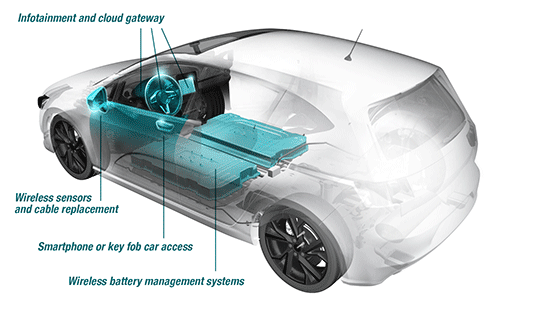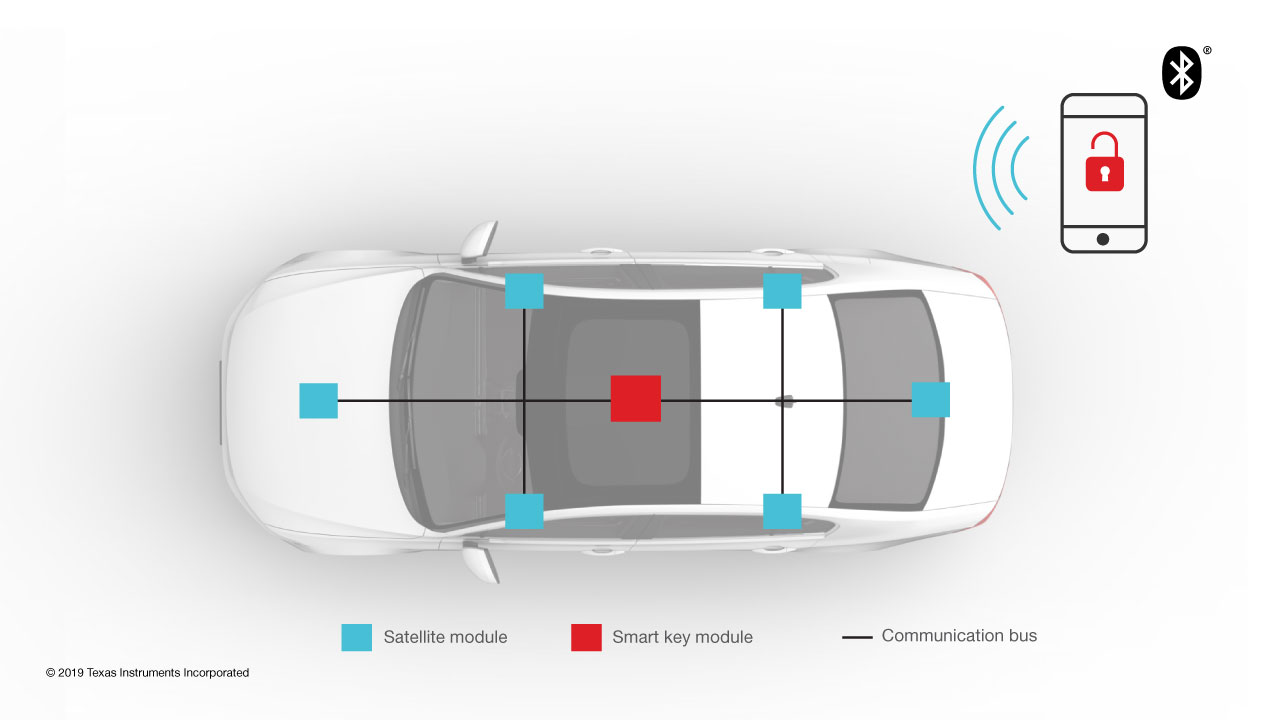By Dan Torres, Product Marketing Engineer, Texas Instruments
Given its extensive ecosystem, low-power nature, and ubiquitous presence in smartphones, Bluetooth Low Energy is becoming the preferred wireless technology for enabling new use cases in automotive applications. Such use cases include phone-as-a-key, cable replacement for body applications, battery-management systems, infotainment, and wireless sensors. Fig. 1 shows some use cases for Bluetooth Low Energy in cars; let’s review each of these use cases.
Phone-as-a-key
The automotive industry is going through an unparalleled revolution as electrification, autonomous driving, and connectivity become an integral part of the car. Vehicles are evolving from being just a transport medium to providing in-car experiences. While many comfort and convenience features are already available, new developments in automotive ecosystems enable occupants to feel more comfortable and fine-tune settings effortlessly. Consumers want their smartphones to provide access to their vehicles while also allowing the customization of their overall in-car experience.

Fig 1: Bluetooth Low Energy in cars
The adoption of Bluetooth Low Energy technology in vehicles started with the modernization of car access systems by enabling the phone-as-a-key feature for passive-entry passive-start systems, providing new user experiences revolving around digital keys and digital profiles. The evolution of secure car access applications brings a corresponding development of specifications that will ensure the security and accuracy of the phone-as-a-key solution.
New possibilities come with the introduction of digital keys and profiles; customization is an inherent benefit that allows drivers and passengers to seamlessly adjust the position of mirrors, seats, and the steering wheel. Based on the location of their respective phones, it is possible to identify the driver and passengers, allowing personalized settings for the infotainment system based on each user’s profile. Additionally, it is possible to create shared keys for friends and family as well as temporary digital keys for valets, making phone-as-a-key a convenient feature for car sharing.
Many vehicles now come equipped with power seats; instead of moving the seat manually with levers, occupants use switches to adjust the seat height, distance from the pedals, seat tilt, and headrest position, as shown inFig. 3 . Premium vehicles also include features such as lumbar support and the adjustment of seat length and width. Moreover, these vehicles have dynamic seat control, a feature that prevents passengers from slipping in the front seats when the car is making a turn.
Bluetooth Low Energy-based key fobs will likely expand in popularity because a key fob must have low power consumption. Resolving technical challenges in Bluetooth Low Energy-based car-access technology will pave the way toward Bluetooth Low Energy key fobs, as well as Bluetooth-enabled smartphones replacing ultra-high-frequency–based key fobs. Fig. 2 shows an example of a passive-entry passive-start system based on Bluetooth Low Energy.

Fig. 2: A passive-entry passive-start architecture in a car. The number of satellite modules will vary, depending on system-level requirements.
Car manufacturers are leveraging the infrastructure built around Bluetooth Low Energy nodes to replace legacy technologies based on low- and ultra-high-frequency bands. Some of the factors driving the adoption of Bluetooth over other wireless technologies include:
- Reliable interoperability with smartphones
- Standardization with a well-defined specification that has a certification process
- High performance in noisy and challenging environments
- Compelling offerings of Automotive Electronics Council (AEC)-Q100–qualified devices
- Low power consumption, especially valuable in the ignition off state
- System cost: cost of system-on-chip, external components, and antenna
Trends with wireless sensors
The consolidation of wireless technologies in cars is helping manufacturers leverage economies of scale in order to reduce costs in features such as tire pressure monitoring systems (TPMS). System integrators are now looking into developing the next generation of TPMS based on Bluetooth Low Energy devices that will allow drivers to check tire pressure using their phone or even receive notifications when a tire is flat.
Low-power in-vehicle infotainment systems
Low power is a key requirement in infotainment systems such as a telematics box and head-unit display. Often, these systems comprise high-power-consuming connectivity devices or elements such as cellular modems (4G or 5G), Wi-Fi, and many other types of connectivity, depending on the vehicle. When in the key-off state, there are stringent power budgets that the vehicle must maintain in order to not drain the battery.
Infotainment systems require low power operation, as they have limited power budgets ( <1 mA) when the car is off. This requirement is forcing system developers to look for low-power wireless microcontrollers and system-on-chips that can duty-cycle the not-so-low power components in the system — more specifically, those devices with high standby current.
Therefore, some sort of system is required that allows the vehicle to shut off the higher-current-consuming components of the vehicle but still wake up when needed. Although there are several options for connectivity within the car, Bluetooth Low Energy is a great option for quality and reliability. It is often used as a way to enable the telematics box or head-unit display and determine whether it needs to wake up to handle over-the-air software updates or other diagnostic functions.
Industry analysts envision that the trend of using Bluetooth Low Energy to connect applications within vehicles will continue as they become more technologically advanced and connected.

Fig. 3: Power seat controls, locks, and sunroof
Cable replacement
Replacing cables in the car with wireless connectivity is a big industry trend as the semiconductor and sensor content in cars grow exponentially. The need to interconnect these body systems to various in-vehicle computers also increases exponentially. This poses a big challenge from a manufacturability, cost, and system complexity perspective. Bluetooth Low Energy is a low-power and cost-effective option to traditional interconnectivity solutions based on Local Interconnect Network or Controller Area Network. It has helped simplify designs to control eight-position power seats, mirrors, locks, and sunroofs.
Another trend is to use Bluetooth radios not only on body applications but in battery-management systems, where the temperature and voltage information reported from battery packs has to be sent periodically to the main computer.
Conclusion
The use of wireless technologies in the electrification of the power train, such as Bluetooth Low Energy, is opening up new possibilities to develop lighter, scalable, and easier-to-manufacture battery-management systems. This gives manufacturers the flexibility to develop battery packs that that could maximize space in the chassis or to create systems that can scale up or down in energy capacity based on the size of the chassis.
Advertisement
Learn more about Electronic Products MagazineTexas Instruments





